Not only do garnishes make your culinary creations look attractive, but they also elevate the flavor of your dish or drink. There are several types of garnishes. They can take the form of sauces, leafy sprouts, or herbs. However, not all garnishes are edible.
Some garnishes offer visual appeal, while others are useful for their flavor. The type of garnish you select will depend on the dish you are serving. However, no matter your choice, keep things simple. Also, ensure the garnish complements the dish.
In this article, we compile a list of different types of garnish. These garnishes will help you add a layer of excitement and texture to your next dish.
Table of Contents
Types of Garnish
Leaves and Herbs
Leaves and herbs are one of the most popular types of garnishes. They add distinct aromas and colors to your dishes. When garnishing with leaves and herbs, the possibilities are endless. You can either use them dried or fresh for garnishing.
Some well-known leaves and herbs used as garnish include:

Basil
Basil is one of the more popular leaves used for garnishing. There are several types of basil, each with a different flavor profile.
Some common varieties of basil include Thai basil, Lettuce Leaf basil, Fino Verde, and Dark Opal. You can find basil in abundance between November and April.
Basil will add a strong sweet and spicy flavor to your dish. As a result, it has become a popular choice for garnishing savory dishes and salads.
Bay Leaves
Bay leaves are another common leaf option for garnishing. They are ideal for flavoring anything from braises to marinades to stocks and stews. They have no visual appeal, so you must remove them before serving the dish.
Chives
Chives are versatile herbs ideal for garnishing meats, salads, vegetables, and egg dishes. Although they are members of the onion family, they are less pungent. They are usually available between September and May.
When using chives as a garnish, ensure you add them just before serving the dish because they are heat sensitive.
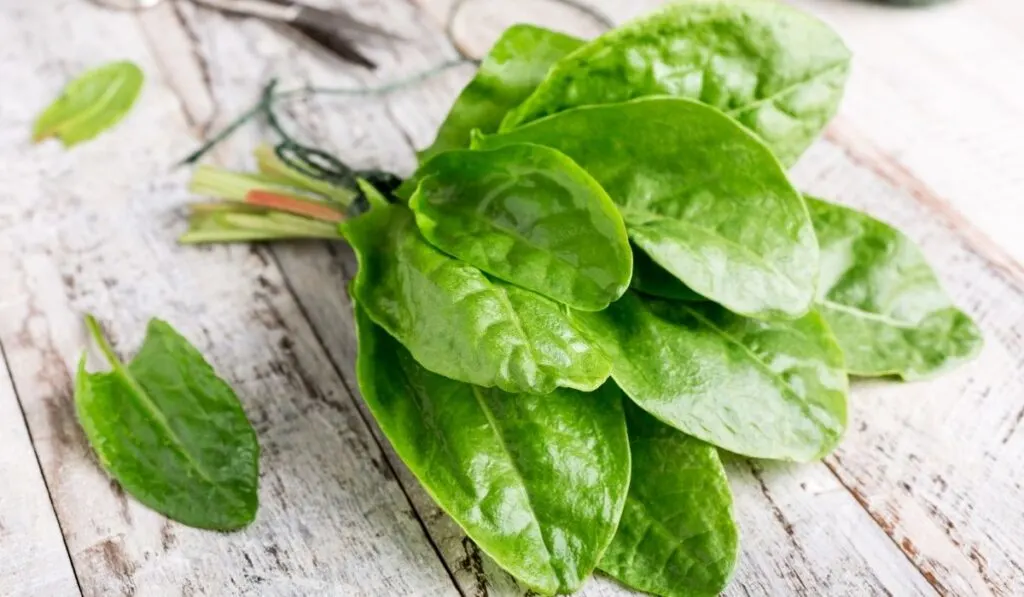
Sorrel
Sorrel leaves are a refreshing, sharp-tasting, and tangy type of garnish.
They are perfect for garnishing sauces, soups, salads, and omelets. They are also a suitable replacement for spinach. Garnishing with sorrel leaves gives your dish a perfect finish and an extra bit of flavor.
Thyme
There are several varieties of thyme, including standard, lemon, dried, and fresh. Standard and lemon thyme are the most common varieties. You can use them raw in salads, soups, stews, stuffing, and braises. You can also mix fresh thyme springs with vinegar or oil to make a marinade or dressing.
Coriander / Cilantro
Fresh coriander leaves are a staple in Chinese, Indian, and Thai cuisine. They are ideal for garnishing chutneys, sauces, stir-fries, curries, and salads.
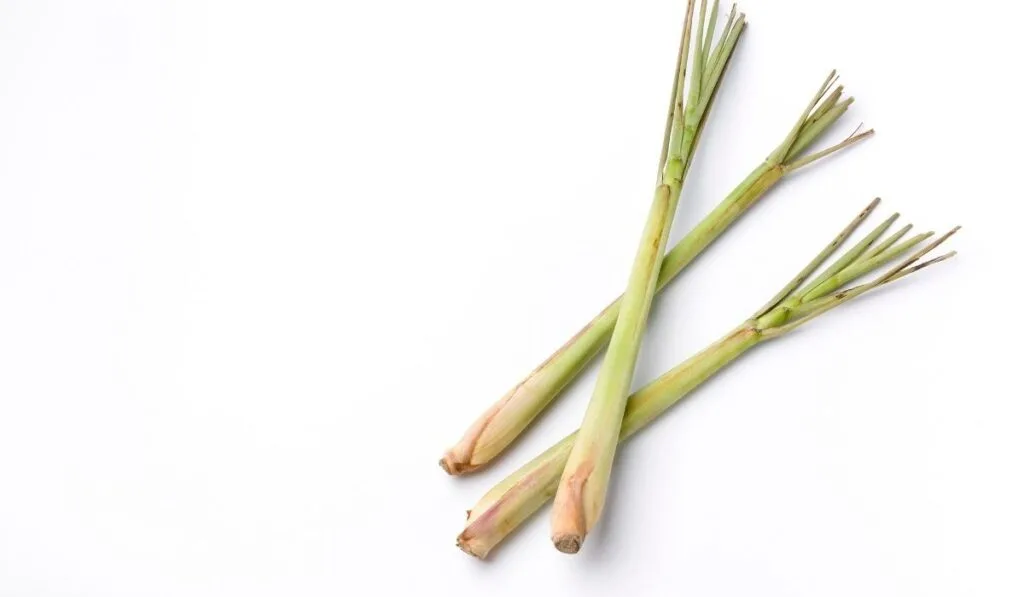
Lemongrass
Lemongrass is another popular ingredient in South-East Asian cuisine. When you use lemongrass leaves and roots as a garnish, they give your dish a great aroma.
Parsley
Parsley is a versatile herb you can use to garnish a range of dishes. You can use it as sprigs or chopped to garnish with. When using parsley as a garnish, add it at the end to preserve its flavor.
The most common types of parsley for garnishing are standard parsley and Italian parsley.
Oregano
Oregano is an aromatic herb known for its earthy flavor and makes an excellent garnish for numerous dishes. You can use oregano to garnish omelets, pizzas, rice, salads, and mayonnaise. It also pairs nicely with courgettes, eggplant, potatoes, and tomatoes.
Oregano features prominently in Greek, Italian, Mexican and Turkish cuisines. In some parts of the world, people refer to it as marjoram.
Oregano is mostly sold and used in its dried state. Fresh oregano has a strong aroma that can overpower your dish.
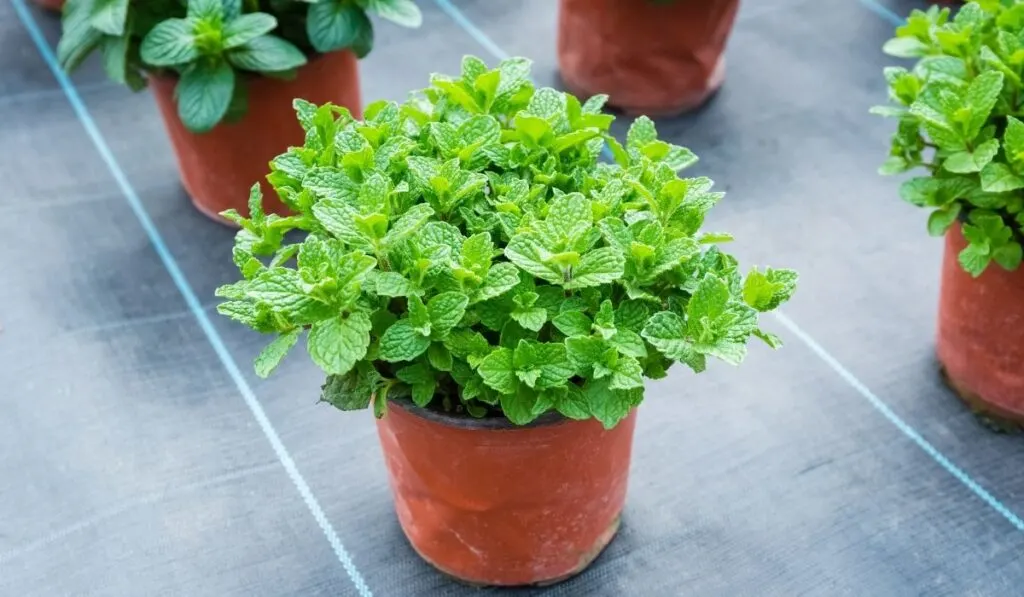
Mint
Mint is a popular herb that features prominently in many Mediterranean and Middle Eastern cuisines. You can use it to garnish numerous dishes, including cocktails, juices, water, desserts, and salads.
Mint pairs nicely with a range of other flavors. It has a similar flavor to thyme when cooked, but it is more aromatic. Several varieties of mint are available, including spearmint, peppermint, and apple mint.
Sage
Sage is a versatile herb with a strong flavor. It makes an excellent garnish for stews, bread, pulses, quiches, soups, and dressings. You can also use whole sage leaves with skewers of meats and vegetables.
When using sage as a garnish, use it in small amounts to ensure it does not overpower your dish. Sage comes in different varieties, including pineapple, standard, and sweet sage.
Rosemary
Rosemary is an herb with a strong and slightly bitter taste that is used in most savory recipes. You can use it to garnish beverages, stuffing, soups, and stews. You can also mix it with oil or vinegar and use it to flavor your salads.
When you cook with rosemary, add it at the beginning to ensure the flavor permeates. You can use it as whole leaves or dried. You can also use its purple flowers as a type of garnish.

Roots
You can prepare roots and use them as garnishes. Some common examples of root garnish are:
- Horseradish: You can peel, grate and place horseradish to the side of your dish to give it some extra spice. You can also mix horseradish with sour cream, vinegar, or lemon juice and add it to steamed vegetables and salads. You can use young horseradish leaves in salads and sandwiches.
- Wasabi: This popular root is usually eaten as a spicy green paste and is a staple of Japanese cooking. You can chop and use wasabi leaves as garnish, while the stems make excellent preserves.
Greens
Greens are edible garnishes often used to line plates. You can also prepare greens and use them as side salads to fill the plate. Popular greens used for garnish include purple kale, butter crisp lettuce, curly kale, and leaf lettuce.
Syrups and Sauces
There are several popular syrups and sauces used for garnishing. Sauces like BBQ, teriyaki, and similar sauces are perfect for garnishing meat. Syrups like chocolate and strawberry are excellent choices for garnishing desserts.

Veggies and Fruits
Popular fruit and vegetable garnishes include tomatoes, lemon, asparagus, lime, watermelon, grapes, berries, and oranges. You can use them for their zest, as wedges or slices. No matter how you decide to use them, they all make great garnishes.
Popular garnishing options with fruits and vegetables include lemon spirals, lime quarters, watermelon chunks, pineapple pieces, orange and lime zest. You can also deep-fry vegetables or vegetable shavings and use them as garnish.
Purees
Another popular type of garnish is the puree of fruits and vegetables. A common type of puree garnish is tomato puree.
You can either spread the puree on the platter or pour it over the food item. Purees give your dish a vibrant flavor, color, and texture.
Nuts
Nuts are perfect garnishes for both savory dishes and desserts. You can use roasted or sliced nuts to garnish a variety of sweet dishes like cakes, cake frosting, and ice cream.
Edible Flowers
Not many people would consider using edible flowers as decorations for their dishes. However, lately, garnishing dishes with edible flowers has become a trend in many professional kitchens.
Edible flowers give your dish a delightful pop of color, making it look more appealing. You can garnish your dish with either perennial or seasonal flowers.
Using both seasonal and perennial flowers helps circumvent availability issues. For instance, calendula and pansies are available all year round, while flowers like nasturtiums are available between September and April. By using them together, you’d have a diverse set of garnish that you can always use.
‘Heart’s Ease’ pansies have a deep purple color and make a beautiful addition to any dish. Calendula petals are common in salads. But since they lack any real flavor, most people use them for their color.
Nasturtiums look similar to pansies but are fragile. They are a popular option due to their bright yellow, red, and orange hues. Their leaves bring a peppery kick to any dish. When you pickle the seeds of nasturtiums, they taste similar to capers.
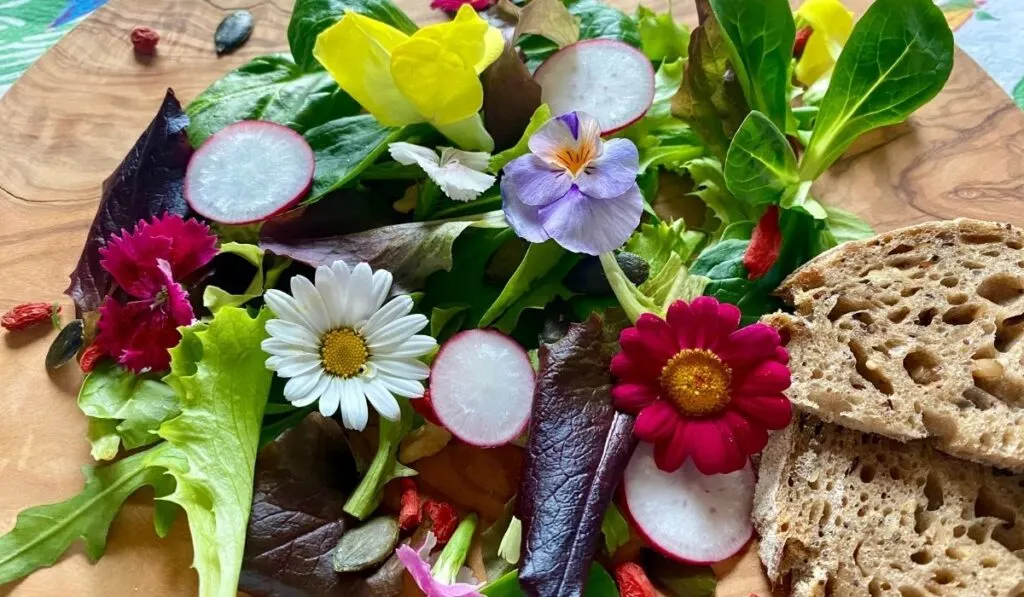
Another popular edible flower option is marigolds, available from April to November. They are similar to calendula flowers, and you can use them to garnish salads. They are also an ideal substitute for saffron to produce a bright yellow hue, specifically in rice dishes.
Cornflowers bloom from November to May. They are bright purple edible flowers that come in pink and white shades.
Verbena blooms from December to April, producing edible white, pink and red flowers. It gives your dish a subtle lemon flavor.
Meat Garnishes
Although meat is not usually considered a garnish, it can make your meal taste better and look more appealing. Here are some ways you can use meat as a garnish:
- Bacon: Sprinkling crumbled bacon is perfect for garnishing savory dishes like soups, eggs, salads, and fish and chicken dishes. You can also use it as a garnish for ice cream and pancakes.
- Shredded Meats: You can use different types of shredded meats as toppings or garnish for pizzas, salads, soups, and several other dishes. You can decide to sauté the shredded meat until it is crispy before using it as a garnish.
Cheese
Cheese is a well-known garnish for pasta dishes, but you can use them as a garnish for other dishes.
For instance, you can grate frozen blue cheese over risotto or even a steak. You can also crumble cheese and add them to salads.
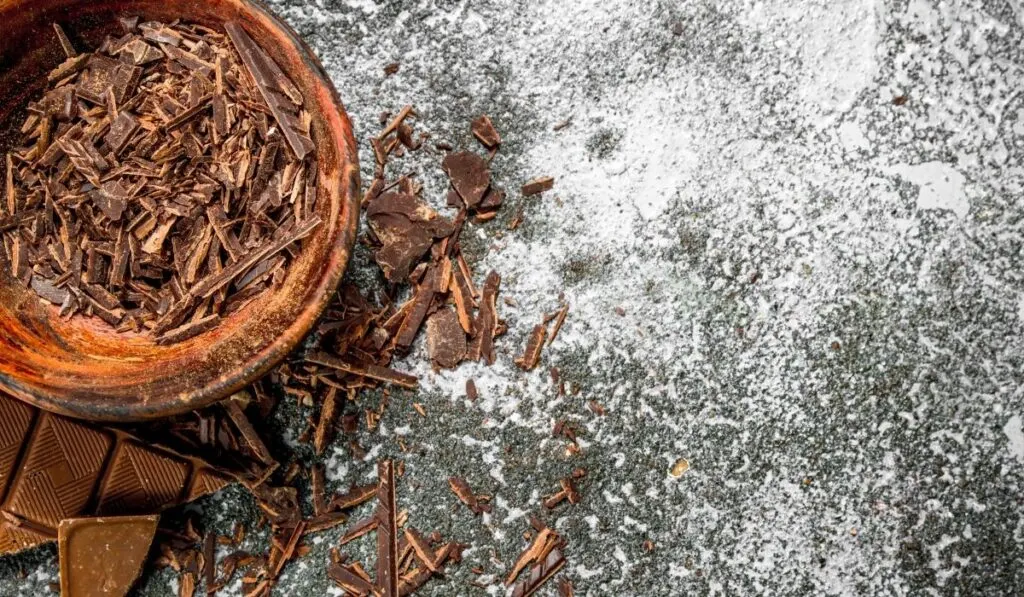
Sprinkle Garnishes
A sprinkle garnish is a quick and easy way to fancy up your dish. Thankfully, sprinkle garnishes are available in a variety of colors and flavors. Here are some sprinkle garnishes you can try out:
- Black Pepper: A sprinkle of black pepper or a mixture of white, red, black, and green peppercorns can make your dish taste better and look more appealing.
- Crunchy Sea Salt: This is an excellent addition to most savory dishes and a few sweet ones. You can go one step further by using flavored salt like chili, smoked, or the pretty Himalayan pink salt. When you sprinkle this garnish, do so in moderation to avoid over-salting your dish.
- Chili Powder, Paprika, or Smoked Paprika: If you sprinkle a pinch of chili powder on your dish, you’d be adding a nice color to the mix. But apart from that, doing such adds extra flavor to your meal.
- Sumac: This deep red spice has a lemony flavor that complements any chicken and fish dish. You can also use it as a garnish for hummus.
- Grated Chocolate: Grated or crumbled chocolate can make your dessert look and taste better.
Resources:
- https://www.homestratosphere.com/types-of-garnish/
- https://www.anchorfoodprofessionals.com/nz/en/inspiration/Performance/garnishes-and-techniques-in-the-kitchen.html
- https://www.suddenlunch.com/food-garnishes/
- https://askinglot.com/what-are-the-types-of-garnishes
- https://worstroom.com/types-of-garnish/
- https://www.leaf.tv/articles/types-of-garnishes-for-food/
